

The innovative technology that powered the Inca
source link: https://www.bbc.com/travel/article/20211213-how-are-romes-monuments-still-standing
Go to the source link to view the article. You can view the picture content, updated content and better typesetting reading experience. If the link is broken, please click the button below to view the snapshot at that time.

Inside the Colosseum's stone and mortar bowl, visitors have ample space to picture the roaring crowds of more than 50,000 that once thronged to the arena for events ranging from bloody gladiatorial battles to opulent processions and chariot races. Also known as the Flavian Amphitheatre, the venue's grand opening in 80 AD featured 100 straight days of games and gore that are said to have included the slaughter of some 9,000 animals. At four storeys tall and 188m across at its widest point, the oval structure remains the largest amphitheatre in the world.
Constructed around 40 years later, the Pantheon houses a mind-bending dome that spans 43m of air and culminates in a pupil-like circular window at its apex known as the oculus that floods the interior with natural light. The name Pantheon, which combines the Greek words for "all" and "gods", suggests a religious function, but some historians think the monument was mainly constructed to pay tribute to Roman emperors. Despite the ravages of time, the iconic half-sphere remains intact and is still the world's largest unreinforced concrete dome.
When it came to building big, the Romans clearly knew what they were doing. Nearly 2,000 years after they were constructed, these two enormous and technically astounding structures have withstood earthquakes, floods and military conflicts, long outlasting the empire that spawned them and becoming physical embodiments of the enduring influence of Roman culture across the globe.
But how did ancient Rome accomplish such monumental, long-lasting architecture so long ago?
Engineers and materials scientists are still studying Roman structures today, and they say the secret is the marriage of ingenious design with an innovative recipe for concrete, a supremely durable and adaptable material that is still used the world over. While the Romans didn't invent concrete, they certainly raised the bar for building with it.
Pouring concrete allowed Roman architects to achieve almost any shape they could imagine, limited only by their ability to construct the wooden forms necessary to mould the rocky slurry. But the arches, vaults and domes that are signatures of Roman buildings were not just flights of fancy.
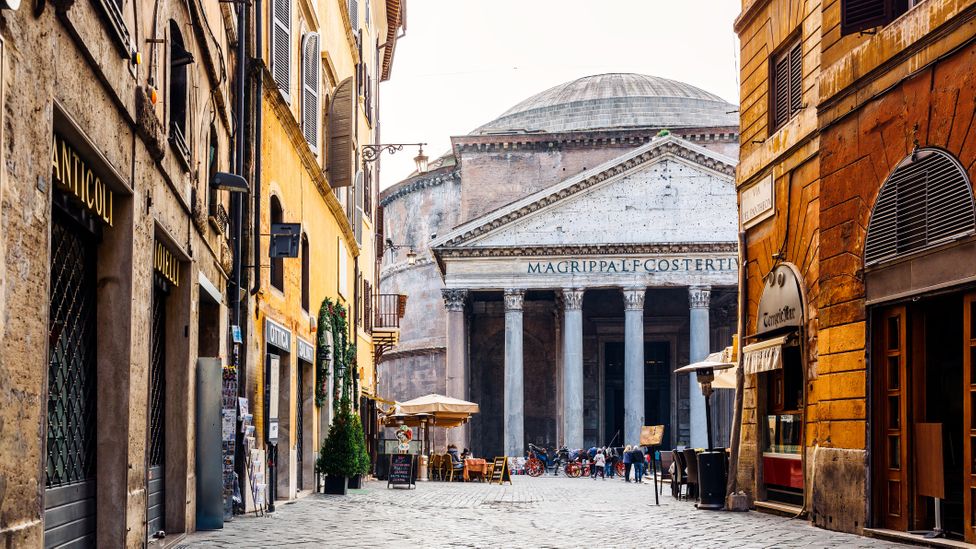
Featuring the world's largest unreinforced concrete dome, the Pantheon is testament to the superiority of Roman building techniques (Credit: Alexander Spatari/Getty Images)
The highest expressions of the Roman Empire's built environment confront modern visitors with an "engineering approach", said Renato Perucchio, a mechanical engineer at the University of Rochester in New York. "The Romans performed sophisticated analyses that led them to these designs, which were then expressed through an extremely careful construction process."
The concrete that held these designs together was also unique and deeply considered. Roman concrete used a different recipe than modern concrete, and researchers studying this ancient material say its ingredients appear to endow the material with phenomenal resistance to degradation.
Today, most concrete is made up of portland cement – a combination of silica sand, limestone, clay, chalk and other minerals that is baked around 2,000C and crushed into fine powder – and pieces of rock or sand called aggregate. Mixing the rocky aggregate, which varies in size from sand to gravel to small chunks of stone, with the cement makes the resulting concrete stronger and saves cement. Finally, adding water to the concrete mix sets off a chemical reaction in the cement that binds these elements together. For the most part, aggregate in modern concrete is carefully chosen to be as chemically inert as possible. The idea is to avoid any unwanted chemistry once this initial reaction concludes, since any additional reactions down the road usually crack or otherwise weaken the concrete.
You may also be interested in:
• The Maya's ingenious secret to survival
• Asia's empire crushed by water
• Yemen's ancient skyscraper cities
Roman concrete, on the other hand, is a simpler mix of quicklime made from baking and crushing limestone rocks and, most importantly, volcanic rock aggregates of various types, which were abundant in the region surrounding Rome. In contrast to the aggregates used in modern concrete, these volcanic materials used by the Romans are highly reactive and the resulting concrete remains chemically active for centuries after it first hardens.
"Portland cements nowadays are not meant to change chemically, and if they do change it's usually going to have a bad effect," said Marie Jackson, a geologist at the University of Utah who has been studying Roman concrete for decades. "Romans wanted their concrete to react. They chose an aggregate that would continue to participate in the concrete processes over time."
In contrast to modern concrete, this ongoing reactivity allows Roman concrete to get stronger over time. These long-term chemical reactions can serve to reinforce small cracks that often form between the pieces of aggregate and the binding cement and prevent them from propagating farther. This regenerative capacity, made possible by the reactive volcanic minerals, is what enables Roman concrete's tremendous capacity to endure.
Modern concrete construction might last 100 years with maintenance, but some Roman structures have survived for 1,000 years or more essentially unassisted
"Sure, we can produce concrete with greater tensile strength today, but so what?" said Perucchio. "Modern concrete construction might last 100 years with maintenance, but some Roman structures have survived for 1,000 years or more essentially unassisted."
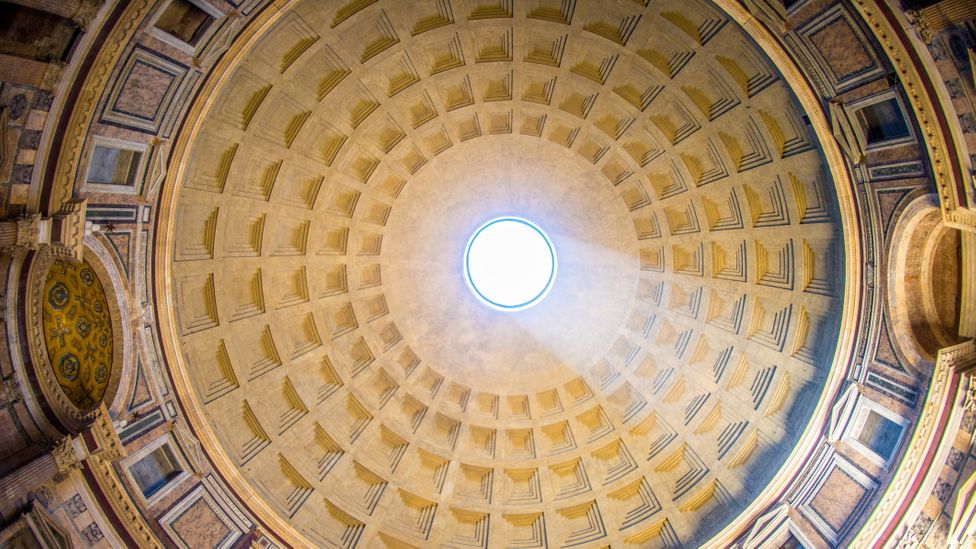
The engineering marvel that is the oculus floods the interior of the Pantheon with natural light (Credit: Edwin Remsberg/Getty Images)
Though researchers had suspected for many years that it was the addition of volcanic minerals that gave Roman concrete its staying power, it wasn't until 2014 that Jackson and others revealed the precise chemistry involved. In their study, they tested a concrete mix based on what was used in the construction of Trajan's Markets in Rome and observed the growth of plate-like crystals of a mineral called strätlingite in the so-called "interfacial zones" between the chunks of volcanic rock and the cement holding the mixture together. The researchers wrote that these crystals served to reinforce these interfacial zones, which are typically the weakest link in concretes made with portland cement, rendering the Roman concrete more resistant to cracking.
Recently, a new study by Jackson and others published in autumn 2021 suggests that crystalline strätlingite isn't the only byproduct of the ancient concrete's ongoing reactivity that keeps it holding strong. The team studied a sample of concrete from the 21m-tall cylindrical tomb of a Roman noblewoman named Caecilia Metella that was constructed around 30 BC near an ancient Roman road known as the Appian Way. This concrete, it turned out, was made using volcanic rocks that contained lots of a potassium-rich mineral called leucite.
Over the course of the 2,000 years following the tomb’s construction, rain and groundwater seeped into the tomb's walls and dissolved the leucite, releasing its potassium into the concrete. In modern concrete, being inundated with potassium would create expanding gels and cause cracking and deterioration.
But Jackson and her colleagues instead found that the reactive volcanic minerals in Roman concrete facilitated a different outcome. The dissolved potassium ended up reconfiguring the chemical "glue" that forms the backbone of hardened concrete, which maintained and enhanced the strength of the material despite containing significantly less strätlingite than the team observed in the Trajan's Market concrete.
As for why Roman concrete’s longevity appears to have a slightly different explanation in these two contexts, Linda Seymour, who worked on the study while completing her PhD at the Massachusetts Institute of Technology (MIT) in the US, said it’s partly “that these structures experienced different environments, which then resulted in different chemical processes". Seymour said the differences can also be accounted for by “the varying chemical compositions of the aggregates the Romans used – but the common thread is this ongoing reactivity that results in a non-detrimental reconfiguration of the concrete over time".
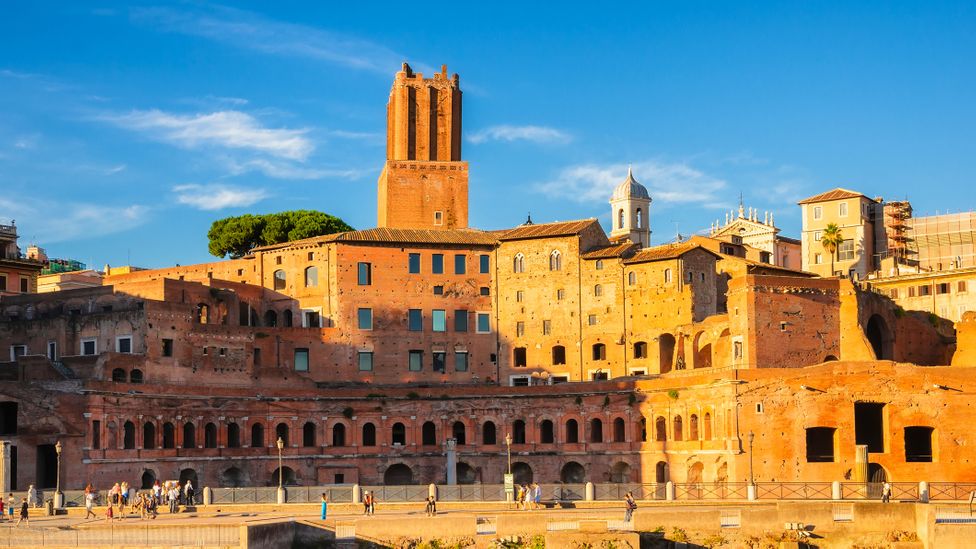
Trajan's Market, an archaeological complex made of red brick and concrete, is often described as "the world’s first shopping centre" (Credit: by Ruhey/Getty Images)
The chemical diversity of Roman concrete likely means not everything they tried worked equally well, but in the Colosseum and the Pantheon we have two irrefutable testaments to the material's success.
At the Colosseum, concrete isn't necessarily the star of the show but it has played an integral role in the arena's survival. The most prominent material at the Colosseum is travertine limestone, but concrete is what holds the amphitheatre's many iconic archways aloft. Yet, perhaps the most significant contribution of concrete to the Colosseum's longevity is out of sight.
"You can't see it as a tourist, but the reason the Colosseum is still standing is because of its incredibly robust concrete foundation," said Jackson. That concrete foundation is packed with dense, heavy lava rock aggregate and is a full 12m thick, she added. Without such a strong, long-lasting material at its foundation, the Colosseum would have been reduced entirely to rubble by the region's earthquakes.
No visit to Rome would be complete without a visit to the Colosseum, but for anyone seeking the pinnacle of concrete construction in the ancient world, Perucchio says the Pantheon's unreinforced dome is a must.
Inside the Pantheon's rotunda, the distance from the floor to the very top of the dome is virtually identical to the dome's 43m diameter, inviting anyone inside to imagine the huge, perfect sphere that could be housed within its interior. When trying to appreciate the Pantheon's dome, "unreinforced" is really the key word.
Perucchio said that if an architect tried to build the Pantheon today, the plans would be denied because without reinforcement, such as the steel bars commonly used in modern concrete structures, the dome would violate modern civil engineering code
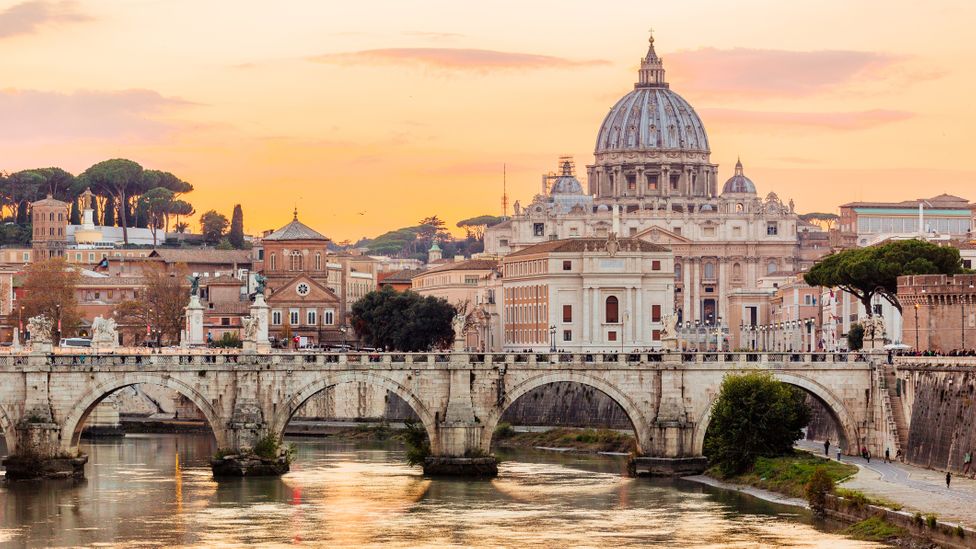
Many of Rome's monuments have long outlasted the empire that built them (Credit: Alexander Spatari/Getty Images)
"The dome creates very high tensile stresses, yet it's been standing for 19 centuries," said Perucchio. "From this you can draw one of two conclusions: either gravity worked differently in Roman times; or there is knowledge that we have lost."
Apart from the unique chemistry of their concrete, the Roman architects behind the Pantheon deployed innumerable tricks to achieve their vision. Two such tricks were aimed at making the dome's walls as light as possible.
During construction, the concrete that makes up the building's half-spherical ceiling had to be poured from the bottom up into wooden frames that formed successive concentric rings. But to ease the immense tensile stresses Perucchio mentioned, the builders used progressively lighter volcanic rocks as aggregate as they got closer to the dome's apex as well as making the walls themselves thinner.
At the lowest, widest part of the dome, the concrete contains large blocks of heavy basalt for strength and is about 6m thick. By contrast, the last layer surrounding the oculus uses airy pumice stone, which is so light it floats in water, as aggregate and is roughly 2m thick.
The second trick can be seen all over the inside of the dome. The curved interior of the ceiling is covered in hollowed out rectangles known as coffers. These geometric coffers are mesmerising, but they're not simply there for aesthetics. They also reduced the amount of concrete required to build the dome and made it lighter, which reduced stress on the materials.
I consider it one of the most extraordinarily beautiful structures ever built
"The Pantheon is a magical place," said Perucchio. "I've been there countless times, but every time I am filled with enormous admiration for the architecture and engineering involved. I consider it one of the most extraordinarily beautiful structures ever built."
In the Pantheon, concrete may have achieved its most sublime form – a book on the structure declares it a "triumph of concrete" – but Admir Masic, a materials scientist at MIT and co-author of the 2021 study, said that in the modern world concrete is "somewhat evil" despite all the useful and even beautiful things it can do. That's because producing the portland cement that goes into today's concrete is responsible for at least 8% of global carbon emissions.
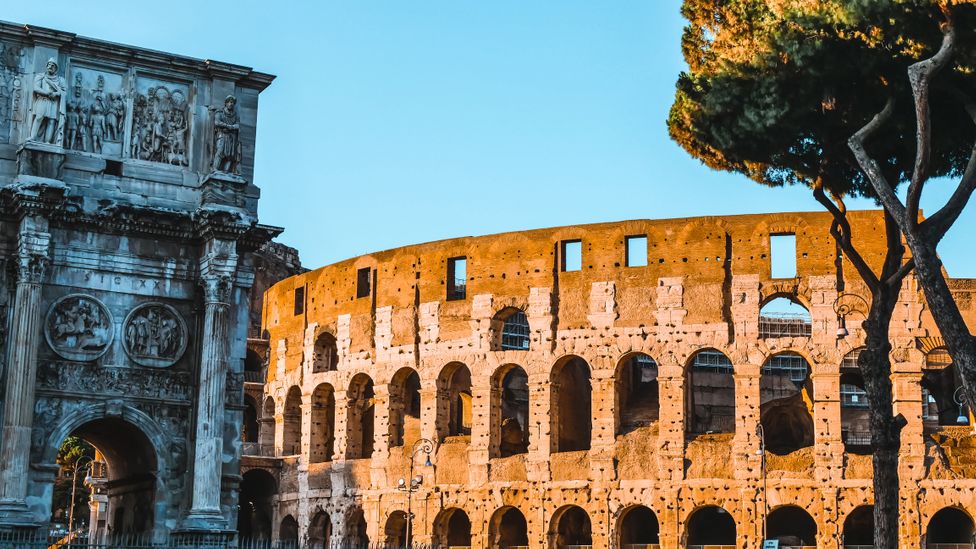
The Colosseum's deep concrete foundation has protected it from the region's earthquakes (Credit: Artem Petro/Getty Images)
Masic and Jackson are studying Roman concrete with an eye towards making today's concrete more environmentally friendly. The biggest advantage of Roman concrete, Masic said, is that its lime-based binder only needs to be heated to around 900C, while portland cement needs to be fired at close to 1,450C.
This alone means that Roman concrete has the potential to offer massive reductions in the carbon footprint of concrete production. But Masic said the material's' longevity could also allow us to replace infrastructure less frequently.
"Imagine we start to build infrastructure that lasts 500 years instead of 100 years, and that we add Roman concrete's self-healing property to every project we do," Masic said. "We might sell less concrete as a result but that's exactly the problem in our current mode of infrastructure. Making things that last longer is perhaps the simplest way to improve sustainability."
Jackson and her collaborators are working on a US Department of Energy ARPA-e project to develop a Roman-like concrete with the goals of potentially reducing the emissions associated with concrete production and installation by 85% and quadrupling its lifespan.
Among the biggest obstacles to wider adoption of the Roman recipe are its long curing time – it can take up to six months to reach full strength, compared to standard concrete's' 28 days – and lower strength (Perucchio said it's approximately 10 times weaker than modern concrete), which means it might fail in some heavyweight modern applications.
But Masic said there are ways of speeding up the chemistry involved in Roman concrete's curing process. He's working on a technique that involves injecting Roman concrete with carbon dioxide that might allow the mixture to cure in a matter of days. "We don't' need to copy what the Romans did exactly," he said, "but when it comes to making concrete more durable and more sustainable, they clearly have some things to teach us."
Ancient Engineering Marvels is a BBC Travel series that takes inspiration from unique architectural ideas or ingenious constructions built by past civilisations and cultures across the planet.
Join more than three million BBC Travel fans by liking us on Facebook, or follow us on Twitter and Instagram.
If you liked this story, sign up for the weekly bbc.com features newsletter called "The Essential List". A handpicked selection of stories from BBC Future, Culture, Worklife and Travel, delivered to your inbox every Friday.
Recommend
About Joyk
Aggregate valuable and interesting links.
Joyk means Joy of geeK